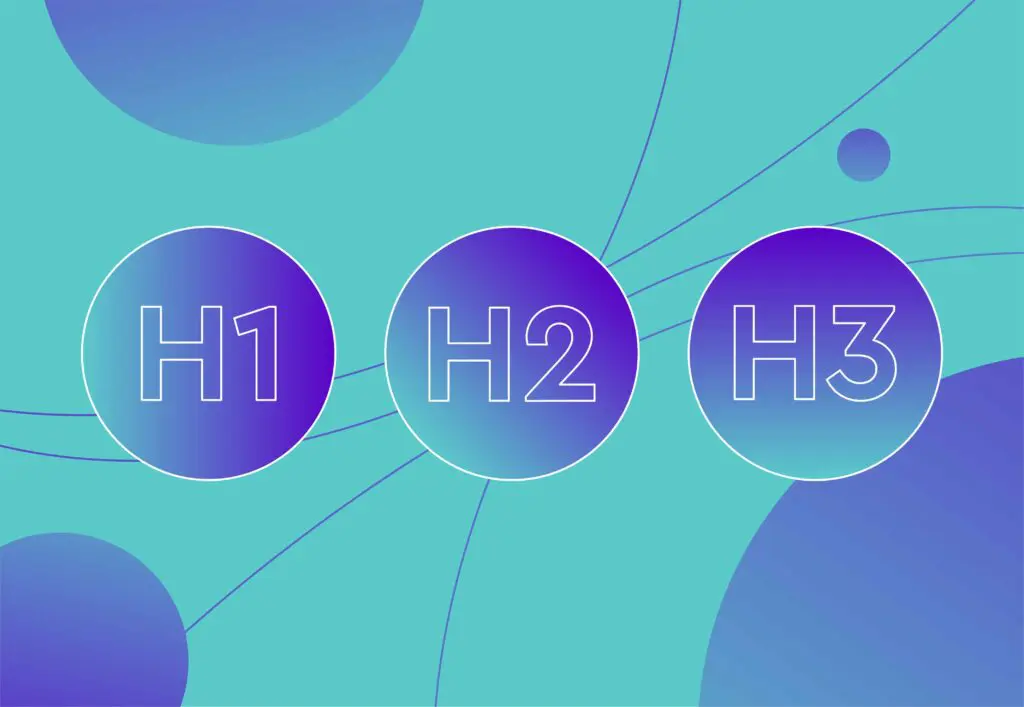
A guide to H1, H2 and H3 tags

When it comes to creating content, your H1 and H2 header tags are among the most important factors you can include on the page. Not only do header tags enable greater search engine optimisation (SEO), but they also provide a solid structure for your content – if implemented correctly.
At Embryo, we’re experts in the world of digital marketing, with our content marketing team being one of the most important aspects of our business. In this blog, we’ll use the invaluable insights gained on the job to teach you all about the world of HTML headings, aiming to help you create high-quality content that draws in readers and pushes conversions.
Want to get started with our content and SEO services?
Header Tags: What are they and how do they work?
So, what exactly are header tags?
Essentially, header tags are HTML tags that are used to set apart headings and subheadings from the rest of the content on a webpage, enabling you to create a logically structured piece of content. The ‘H’ stands for ‘heading element’, although the SEO community usually refers to these tags as ‘header/heading tags’.
There are six types of SEO headings typically used – they descend in order of importance from H1, all the way through to H6. However, it’s unlikely you’ll ever need to use H5 and H6 tags – the most commonly used header tags are H3, H1 and H2 tags.
Let’s take a closer examination at these HTML tags:
- H1 tags: H1 tags act as the display title of a post, providing context to the reader and search engines. H1s are often the most important header on a page, telling the reader what the primary focus of the content is and drawing their attention to your content. There should only be one H1 per page.
- H2 tags: H2 tags act as subheadings under your H1 tags, breaking the content down into different sections to make reading easier. Several H2 tags should be used within your content (particularly if it’s a long-form content piece you’re creating) and it’s a good idea to use semantic keywords within your headers to provide further context to your readers and search engines.
- H3 tags: H3 tags are usually used to divide your H2 subheadings further, able to explain points made within the larger subheading. H3s add more textual context and help to make your content easier to digest – they can also be used for formatting lists and bullet points.
- H4 tags: H4 tags are similar to H3 tags as they further clarify the points made in those headings.
You may find that your content doesn’t require H4 tags, depending on the length of the piece and the topic you’re writing about. However, H1s, H2s and H3s are essential for creating an optimal page and website design for modern search engines.
Article headings are essential for modern businesses, integral to your overall website design. They’re more than just a way to style and design your content, playing an important role in boosting the user experience and ensuring your SEO approach is as efficient as possible.
Understanding the importance of header tags is imperative when aiming to create effective web content: Let’s find out why in the next section.
Improve your organic search results
If you work in the digital marketing world, you likely have an understanding of SEO already. Header tags are one aspect of SEO that is often overlooked, which is a shame as they can be incredibly useful. Not only do HTML tags add structure to a page, but they also bring attention to the most important themes and keywords within your content piece. Header tags add readability and help to optimise your keyword relevancy, making them essential parts of any modern SEO strategy.
Heading tags are used by search engines to understand the structure and context of your content, improving your page’s ranking by making it easier for search engines like Google to crawl and index your page. H1 tags are particularly important in this area, as they help to define the main topic of your page and often include major keywords linked to the subject. When you include headings that are keyword-rich and highly contextual, they’re likely to rank higher on Google and thus make your site more visible to potential customers.
Essentially, structuring your content with clear and logical heading tags sends a strong signal to search engines that your content is credible and authoritative, helping you to achieve higher search rankings in the process.
An enhanced user experience
However, whilst it’s important to learn SEO techniques like this, your header tags also have another purpose: Boosting the overall user experience.
After all, it doesn’t matter how well your content ranks on Google – if your content is poorly set out or is hard to read, it will put people off, resulting in a much lower conversion rate.
It’s important to ensure you have a well-structured page with clear header tags, as this makes the content much more accessible and allows the reader to effectively scan the page for their desired information. Your readers can source the key sections they need in an instant, improving engagement and reducing your bounce rate. This is because when content is easy to navigate, people are more likely to stay on your page and engage with your business.
It’s common for people to skim-read content nowadays, so you should always ensure your headings act as signposts, pointing your readers in the right direction. Complex topics can be broken down into more digestible sections, which is particularly important if you’re writing for a technical client. If your readers don’t understand your product, then they’re likely not going to bother buying from you. However, using different headings enables you to both educate and keep the attention of your audience, communicating your desired message in a simple way.
Header tags also help readers with accessibility issues read your content. For example, if a customer has dyslexia or is partially sighted, breaking your content down into smaller chunks may make it easier to read. It’s important to consider your entire audience spectrum before creating your content so you don’t alienate anyone – not only will this enable all readers to access your services, but it will show potential customers that you care about their needs.

Deeper Insights
- What Makes Embryo’s Content Marketing Stand Out From the Crowd?
- The Importance of Keyword Research
- 24 Impressive SaaS Content Marketing Stats
Of course, implementing suitable header tags can be difficult if you’re new to the world of SEO. To help you gain more invaluable insights, we’ve created this next section to guide you through the best practices when using these tags within your content.
Following these practices is essential for maximising the benefits of your HTML tags, as using them incorrectly can affect both your overall optimisation and page structure.
Always take a hierarchical approach
First things first: Your heading tags should always follow a hierarchical approach. Jumping directly from an H1 title tag to an H3 header will confuse both Google and your readers – instead, you should use the standard progression of H1 to H2 to H3.
For your main page title, an H1 should always be used – however, you should only use one H1 per page. This is because using more than one H1 can confuse search engines and dilute the content on the page. Instead, the rest of your structure should focus on H2, H3 and H4 tags, implemented hierarchically.
For example, H2s should designate major sections of your content, with your H3s and H4s used to create further subsections on your page.
You can find out more about the importance of a good H1 headline here.
Create a tactical keyword strategy
Keywords are the bread and butter of the SEO industry, acting as a major part of any content strategy. Incorporating relevant keywords into your header tags is of particular importance in this area – especially in terms of your H1 and H2 tags. However, it’s important to avoid keyword stuffing as this practice can have a negative impact on your performance and readability. Instead, you need to make sure your keywords are contextually relevant, instead of shoehorning them into your content at random.
Your keywords should flow naturally and organically within your H1 and H2 tags, accurately reflecting the content within the section and page. As the most prominent heading on your page, your H1 tag should usually feature your primary keyword, whereas secondary keywords may reflect better when placed in your H2 and H3 headers.
Long-tail keywords may help you capture more specific search queries, allowing you to target more niche areas that your readers may be searching for more information on. It’s important to remember to avoid keyword stuffing though – make sure that your keywords always look natural if you are using long-tail keywords within your content.
Keep your headings clear and concise
Whilst your headings should always be descriptive and include keywords where possible, it’s important that they remain clear and concise. It’s all about finding the right balance between being descriptive enough to give Google and your readers a clear understanding of your topic, without making it too complicated. Whilst your header tags should be informative, if they’re too lengthy, they’re likely to put people off and reduce the readability of your content, making your content less accessible.
Accessibility is another key consideration when implementing new heading tags into your content. As previously mentioned, your copy should be suitable for a wide spectrum of your audience, including those with disabilities or people who use screen readers.
Screen readers are tools used by visually impaired people, enabling them to digest the content on a page. In many cases, a screen reader tool will literally read the text from the page out loud, enabling people with visual difficulties to access and interact with digital content. If your headings are too complicated, consumers may struggle to understand their screen reader, which will likely increase your bounce rate.
Additionally, your headings should not be chosen solely for their stylistic appearance (such as font size and colour). Whilst it’s important that your H tags fit your brand guidelines, the aim is for substance over style, so they should be properly coded using the correct HTML tags.
Learn more about how we create content below:
Master your content with Embryo
As you can see, header tags are one of the most important parts of an effective content marketing strategy, giving you the tools needed to draw in new customers to your brand. However, there are several rules you need to follow to bring out the full potential of your content – otherwise, your new digital marketing campaign may not be as successful as you’d hoped.
If you’d like some help with creating the perfect organic SEO strategy, we’ll be happy to help.
At Embryo, we see what others don’t. Want to find out how it’s done? Enquire with our team today.


